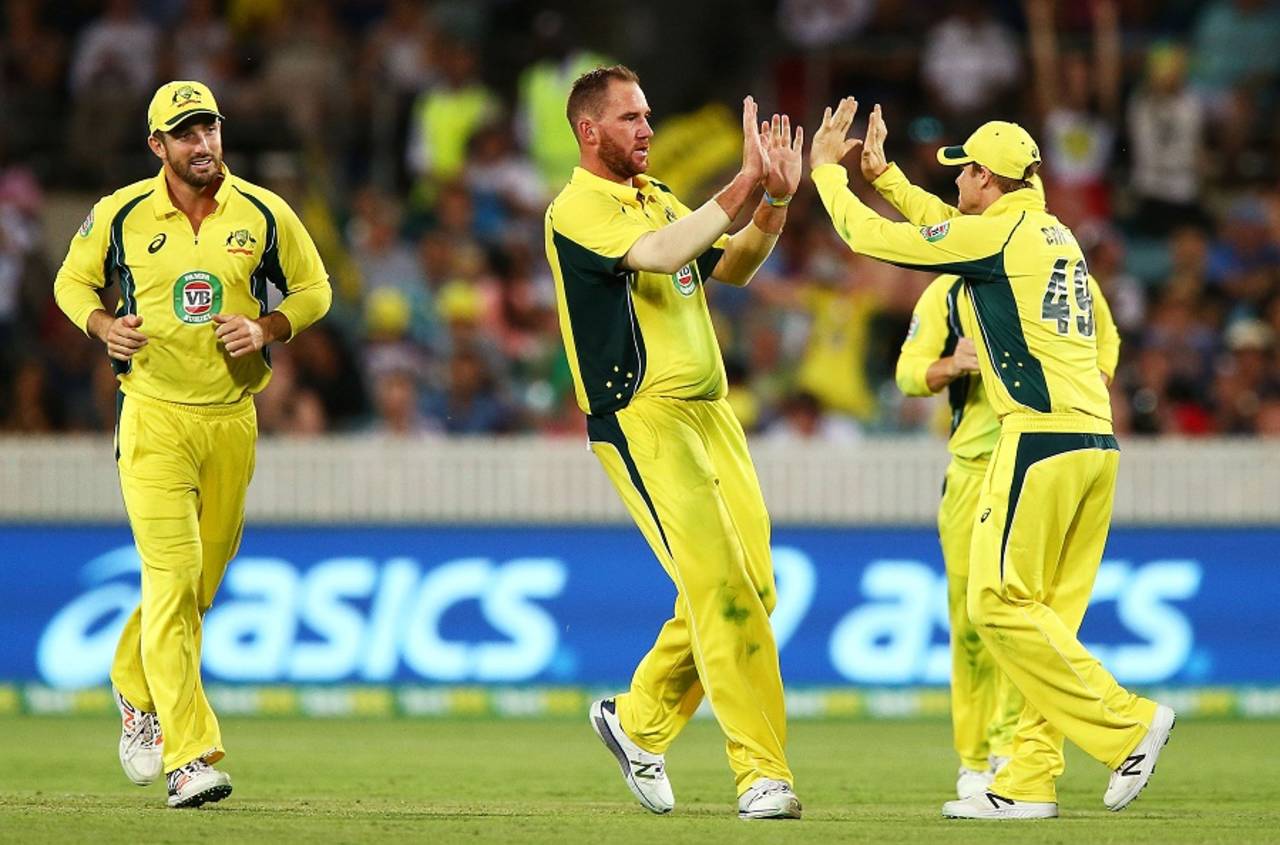'When you stop fighting, that's death'
It is easy to picture
John Wayne Hastings delivering such a punchline. He is, after all, quite a throwback to the archetypal ultra-manly Australian cricketer of the '70s and '80s - strongly built, bears ample facial fuzz and wears a perpetual frown. Hastings has got a reputation to keep too, with his father, a big fan of westerns, having named him after a colossus of the genre. Thanks to the connection with actor John Wayne, Hastings, too, is nicknamed 'The Duke'. "It's one of those things you learn to grow up with when you are younger," and he admits to having fancied growing up to be a cowboy.
But beyond the machismo, Hastings would probably identify more with Wayne's line above considering his "fight" against what he calls "unfortunate" injuries. In over five years of international cricket, he has played only 20 ODIs and seven T20Is besides a solitary Test. Eleven of his ODIs and three T20Is came before September 2011 and his next round of international matches would come four years later.
Hastings'
comeback in 2015 was uninspiring as he conceded 56 runs in 6.2 wicketless overs in a game where England chased down 300 with 10 balls to spare. But a different Hastings turned up at the
decider in Manchester; he registered figures of 10-2-21-3 and, along with Mitchell Marsh, shot out England for 138 to help Australia win the series.
He strung together more consistent performances during the India series where he took 10 wickets from four games at less than six runs an over and finished as the highest wicket-taker in the series. While he continued to do well in the New Zealand one-dayers, he was a touch on the expensive side in the T20s against South Africa. But going into the World T20, Hastings finds himself as one of Australia's more valuable bowlers, ironically because of an injury to Mitchell Starc, who is not in the squad, and with Nathan Coulter-Nile and James Faulkner having only recently recovered from shoulder and hamstring troubles.
At 30, Hastings believes his body has finally become sturdy enough to withstand injuries. "I think the main thing is I had a lot of injuries when I was younger. I participated in the 2011 World Cup... So I've been in the scene for a while but I've not had a lot of opportunities. That's because my body has let me down whether it's an ankle injury or shoulder or back or something. It's been unfortunate injuries. Some of them have been [freakish].
"But I feel now that I've played a lot of cricket, my body - touch wood - is going really well. That's probably the main factor why I'm doing better. Now I am more experienced and my body is used to bowling a little bit more now."
The major reasons for Hastings' success against India was his relentless adherence to bowling shorter of a length outside off stump and slipping in a few slower deliveries to mix things up. By his own admission, subtlety is his best ally. "As a bowler the hardest thing is to try and eliminate some of their shots," he said. "Trying to take away their leg side... If they move around the crease they can hit you over cover, they can move across and hit you through midwicket. They have the lap shots and all these type of things. I think it's hard as a bowler to predict what is coming next. For me, I try and hit a similar sort of area on the pitch and subtle variations. It's about trying to be not as predictable as you can."
Hastings, though, is aware he will have to quickly come to terms with lesser bounce on offer on Indian surfaces. He admitted that the transition was hard to effect, especially at such short notice. "I think our plans will change slightly. We just came off playing in Australia and South Africa where traditionally the ball carries through so you can afford to be back of a length trying to get the nicks to carry or get a catch in the outfield," he said.
"But we have to bowl more at the stumps [here]. It can be difficult to reassess. For me it is little bit more difficult because it's not my natural length. We just have to be a little fuller and bowling at the stumps and not be too predictable. If we're too slow to react, then the game can get away from us."
Hastings has benefited from being a good listener, not only to his Australian team-mates but also in his interactions with other international captains during his time with Chennai Super Kings in the IPL. He attributes his growth to taking on board a lot of feedback on offer, and feels he is only just getting higher on the learning curve.
"I learnt a lot during the 2011 World Cup. We had Brett Lee, he's the one I have learnt an awful lot from. Obviously having [Craig] McDermott around has been fantastic. He has had a lot of experience playing around the world so he is very knowledgeable," he said.
"You just have to sit down and listen to these guys speak. Being at Chennai in the IPL was good as well. To get to be around [MS] Dhoni, [Dwayne] Bravo, [Brendon] McCullum, Faf [du Plessis]... these guys are international captains so I learnt a lot through that… just what their mindset is in trying to set up a batter or in different conditions on what ball to bowl when.
"It's good to have feedback from these guys. That's the only way you learn. By sitting around and talking and watching some footage and understanding what ball could I have bowled differently there."
Arun Venugopal is a correspondent at ESPNcricinfo
